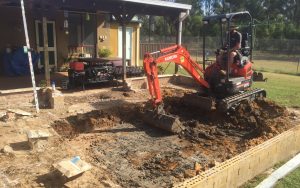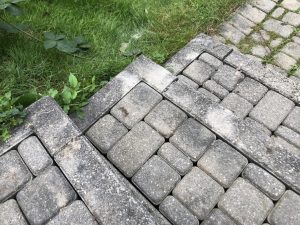How To Install A Sunken Patio into Grass or Ground
by Simmy Parker
If you’re looking to enhance your backyard, it may be worth considering building a sunken patio. They quite literally add another layer to your outdoor space, consequently evoking a sense of tranquility and privacy.
Plus, it’s an exciting outdoor project which gives you the opportunity to get creative. Whether you want to add in a fire pit, wall seating, or any other features for that matter, we’ll leave it to your imaginative streak.
To help you along the way, we’ve put together a short guide on how to go about installing a sunken patio area into grass or ground.
| Iron Embers Cottager Fire Pit |
|---|
|
Plan
First up, you’ll need to plan the project! This means accounting for materials, costs, and of course, assessing the area. Don’t forget to investigate any local bylaw restrictions that may exist first.
Assess The Area
What does the area currently look like? How deep will the excavation need to be? The chances are that you’ll be dealing with a considerable amount of soil, several feet worth in fact.
The initial stages are a great time to determine how you’ll be repurposing this soil. To offer you some food for thought, you could use it to establish new flower beds, or even to replenish existing spots in your backyard.
If you can’t find a use for the soil, you may choose to get rid of it, but ought to bear in mind the cost of doing so.
Excavation

The excavation phase makes up a significant proportion of the project, both from a time and effort perspective.
By this point, you should already have planned where the sunken patio will be located, as well as its dimensions. For utmost accuracy, we recommend mapping out the perimeter of the excavation site using taut string or pencils stuck into the ground.
Once you’re ready to commence digging, you’ll most likely need a traditional excavation tractor. There can be rented from a multitude of places so head to Google and get searching!
Getting this stage right is critical to the success of the entire project. So don’t forget to ensure that that both the perimeter of the site as well as patio base are nice and even. Use dirt to level out the dips, and extra digging to adjust any rises.
Drainage
Additionally, it’s imperative to map out and excavate draining areas and paths, or else you risk winding up with a pond rather than a patio! Whether you opt for a french drain or PVC pipe, this stage is non-negotiable.
Building

With the excavation stage completed, you can begin building the foundation. The first step here is to build out the outermost wall of the patio area by way of typical brick laying work.
Simply line cinder blocks along the edges of the patio, using a mallet to fit them well, and a level to ensure that they’re straight and orderly. Using a trowel, spread mortar along the top of them. Repeat this ritual and continue layering until the wall reaches your preferred height.
Once you’ve built up one edge, continue building the wall in all directions.
We recommend leaving up to ten inches between the top of the wall and ground level, to give you the opportunity to finish them off with defining and aesthetically-pleasing cement capping stones.
Steps

Unless you plan on jumping down to the patio, you’ll want to build in one or two sets of steps leading to it’s base. The materials you choose will depend on the look you’re after. Whether you choose stone, timber, concrete, pavers, or even to insert a nifty little railing, the decision is all yours!
Pave The Way

With the foundation in place, the next step is to ensure that the patio base is even. To do so, level down the soil and deposit a few inches of gravel and sand over it. With the help of a tamper, ensure that the base is firmly packed into place. After this, you can go ahead and begin laying down your pavers, or if preferred, pour your concrete.
If opting for pavers, remember to fill the cracks between them with jointing sand and use a little water to help the sand settle in well.
No matter which terrain you choose, you’ll need to account for the drainage system by tactfully creating a gentle slope towards it.
Additional Features
Finally, you can design the patio however you wish. To save space and achieve an overall natural look, many choose to build in wall seating.
If you too, choose to go down this route, you may find the following materials handy: corner blocks, york blocks, dublin blocks, and masonry adhesive.
For added luxury, we’re all for building in a fire pit!
Overall, there’s no doubt that building a sunken patio has the capacity to dramatically alter one’s backyard, for the better! Whilst the project is one that’s quite extensive and at times, technical, we’re pretty sure it will be worth it!
Video How-To’s
Related posts:
- The Best Types Of Naturally Bug And Rot Resistant Wood For Patio Furniture
- How to Winterize a Gazebo
- Advantages and Disadvantages of Rattan Furniture
- Advantages and Disadvantages of Wicker Outdoor Furniture
 |
 |
 |
 |

About Simmy Parker
Simmy is an outdoor expert who loves to spend time in the wilderness. She received a BS degree in Civil Engineering at Sacramento State University, and has put her skills to use by helping design and build some of the most impressive structures in the world. However, Simmy's true passion lies in sharing her love of nature with others, and she spends much of her free time leading hikes and teaching people about the flora and fauna that can be found all around them.
Thoughts on "How To Install A Sunken Patio into Grass or Ground"
 |
 |
 |
 |
Backyard Stuff
You can Get FREE Gifts. Receive Free Backyard Items here. Disable Ad Blocker to get them all now!
Once done, hit anything below
 |
 |
 |
 |
